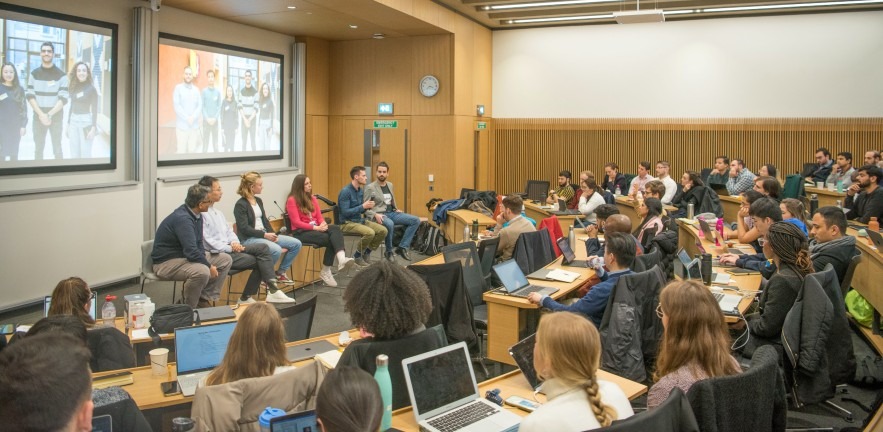How EnterpriseTECH comes together as a unique learning experience
Each cohort has the same format: Programme Launch, the 40-hour lecture and workshop intensive, the research spell (including market research) on your projects and three supervisions helping you relate the taught material to your project, Then there is the assignment prep, Pitch Night and assignment submission.
You are assigned to teams and projects about a week before the programme starts. You find out which project you’ll be working on and who your fellow teammates are when we introduce you via the Project Pack.
Your team’s challenge is to investigate the commercial potential of the technology described in your project pack and what a route to market might be. You’re supported through this process with the guidance of a business supervisor and regular meetings with the inventor team.
A Certificate of Completion is awarded when you successfully complete the programme.

Key elements
- Programme Launch
- 40-hour lecture and workshop intensive
- research spell on your projects
- three supervisions
- assignment prep
- Pitch Night
- assignment submission
The lecture curriculum
Our lectures and workshops are delivered by Cambridge Judge Business School faculty, staff, fellows and many specially invited expert speakers. The content is entirely bespoke, tailored for the practical nature of the programme. While there are many general principles of entrepreneurship, the overall content has a strong focus around the evaluation of the commercial feasibility of bringing new STEM technologies and inventions to market.
Venturing into entrepreneurship: beginners notes
Entrepreneurship offers tremendous value by opening doors to innovation, growth and impact. When you cultivate an entrepreneurial mindset and skillset, you can effectively turn your ideas into successful businesses, understand the commercial potential of your work, secure funding, build valuable industry networks, and enhance your professional abilities. In this first theme, we dive into the theoretical foundations, practical skills, and real-life experiences of accomplished entrepreneurs.
- Process models for innovation and entrepreneurship. Professor Stelios Kavadias, Margaret Thatcher Professor of Enterprise Studies in Innovation & Growth, Co-Director of the Cambridge Judge Entrepreneurship Centre.
- Marketing, customer centricity, and insight in the startup world. Professor Jaideep Prabhu, Jawaharlal Nehru Professor of Indian Business & Enterprise, Vice-Dean for Faculty, Director of the Centre for India & Global Business.
- Entrepreneurial success and failure. Professor Matthew Grimes, Entrepreneurship and Sustainable Futures, Director of the MPhil in Innovation, Strategy & Organisation Programme and Co-Director of
the Entrepreneurship Centre. - Creative Disruption: What will it take to create the tech company of the future? Ajay Chowdhury, Tech entrepreneur, writer, theatre director and Chairman of the Board for Cambridge Enterprise.
- Journeys in entrepreneurship. Shirin Dehghan FREng, Founder and CEO at Oxford Algorithms, AI and Financial Markets and Dr Jana Voigt, CEO, InferSens Ltd.
- Watercress – plant or medicine? Dr Kyle J Stewart, GP and CEO/Co-Founder of Watercress Research.
- A molecular pathway approach to become an entrepreneur. Dr Rodrigo Santos, Entrepreneur in Residence at BiOrigin, Novo Seeds, and previously Director of Cell Technologies at Mogrify.
Entrepreneurial mindsets and amazing teams
Learn to build and lead teams with talks and workshops that offer tools and insights. Establish a culture of clear goals, unified commitment, and team enjoyment. Self-analysis and interpretation of cognitive and personality profiles can help identify areas for growth and improve understanding of strengths and weaknesses.
- Assumptions, joys and pains of working in a team. Dr Helena Kim, Author and coaching psychologist. High performance teams: building your SHIPS. Paul Bourne, Artistic Director of the Menagerie Theatre
Company and Fellow of Creative Engagement, Cambridge Judge Business School. - Entrepreneurial mindsets and great teams. Dr Jason Mellad, CEO and Co-Founder, Start Codon. Associate in Entrepreneurship, Cambridge Judge Entrepreneurship Centre.
- Unleashing team synergy through the EPIC team-building. Paul Bourne, Artistic Director of the Menagerie Theatre Company and Fellow of Creative Engagement, Cambridge Judge Business School.
Balancing innovation and legal protection
For early-stage ventures, protecting their intellectual property is a number one priority. Intellectual property encompasses a wide range of assets, including patents, trademarks, copyrights, and trade secrets, all of which are vital to building a competitive advantage and attracting investment. At the same time, entrepreneurs must balance their need for legal protection with the need for continued innovation. Too much emphasis on protecting their intellectual property can stifle creativity, while too little can leave their innovations vulnerable to competitors.
- You have had a clever idea, so what’s next? Engaging with legal counsel. Julia Gwilt, Partner and Dr Kealan Fallon, Appleyard Lees.
- Founders keepers: IP strategy for entrepreneurs. Joseph Simon-Brown, Partner, Patent Attorney, J A Kemp LLP.
- Intellectual property and business models. Dr Keivan Aghasi, Lecturer in Entrepreneurship, University of Sheffield.
- My journey with Opto.bio: beginnings, barriers and breakthroughs. Dr Ben Woodington, Co-Founder of Opto.bio, PhD Neural Engineering & Bioelectronics from University of Cambridge.
- Innovating the future: the journey of Mimicrete’s IP from concept to market. Dr Liz Zijing Li, COO and Co-Founder of Mimicrete.
- First steps in the commercialisation journey of a university idea. Dr Margaret Wilkinson, Deputy Head of Physical Sciences, Cambridge Enterprise.
Where to start in evaluating business ideas
When it comes to early-stage STEM-based ventures, evaluating business ideas is just one piece of the puzzle. In this competitive landscape, entrepreneurs need to ensure that their ideas have a viable market and a solid business model before investing significant time and resources.
One tried and tested strategy for evaluating business ideas is to conduct market research. This involves identifying the target market, understanding customer needs and preferences, and assessing the competition. By gathering data on the market size, growth potential, and key trends, entrepreneurs can gain a better understanding of the viability of their business idea and make informed decisions about how to proceed.
- From market entry to profitability: navigating the commercialisation process. Dr Chris Coleridge, Management Practice Associate Professor at Cambridge Judge Business School, and Founder and CEO of Carbon13 Venture Builder.
- Finding your niche: strategies for targeting the right customers and markets. Dr Keivan Aghasi, Lecturer in Entrepreneurship, University of Sheffield.
- Navigating the due diligence process. Andrew Hatcher, Managing Director, The Applied Knowledge Network Ltd.
Business models, customer profiling and branding
Market research techniques like customer profiling and macroeconomic analysis help pinpoint potential customer desires, guiding the development of a compelling value proposition. Using tools like the business model canvas offers a visual overview of critical business elements, such as customer segments and revenue streams, aiding in identifying opportunities and gaps. The goal is to achieve product-market fit, ensuring the product meets customer needs while remaining financially viable. This process requires continuous analysis to adapt to changing market conditions. Branding and messaging are key to distinguishing a business, building a unique identity that resonates with customers. This involves selecting a visual language that establishes a psychological connection, fostering trust and loyalty.
- Unpacking the business model canvas. Ludo Chapman, Founder, The Innovation Practice.
- Customer profiling, market analysis and tools for conducting market research. Dr Keivan Aghasi,
Lecturer in Entrepreneurship, University of Sheffield. - Beyond launch: navigating the journey to product-market fit. Tom Britton, Co-founder, SyndicateRoom.
- Mastering the message. Simon Hall, Director, Creative Warehouse.
- The alphabet model to grasp the basics of today’s marketing. Andrew Hatcher, Managing Director, The Applied Knowledge Network.
- Connecting with your customers: wow branding can influence perception and build trust. Mario Prelorenzo, Managing Director, JDJ Creative, Cambridge.
The landscape for startup funding
The landscape for startup funding In the UK, startups typically go through several rounds of funding to fuel their growth and development. The first round of funding is known as pre-seed funding, which typically comes from the founder’s personal savings or friends and family. This funding is used to validate the business idea, develop a minimum viable product, and establish the startup. Once the pre-seed stage is complete, startups can seek seed funding from angel investors or venture capital firms. Seed funding is typically used to fund early-stage growth and to expand the business. This funding round is usually focused on proving the concept, demonstrating market traction, and generating early revenue.
- To exit or not to exit, that is the question! Prashant Shah, Co-CEO & Co-founder of o2h group.
- You have the attention of the venture capitalists – now what? Ed Rayner, Commercial Director, Blok Bioscience.
- Aqdot: the Journey of a chemtech company. Dr Jing Zhang, Co-founder and Strategy Director, Aqdot.
- Turning ideas into innovations. Dr Hitesh Sanganee, Head of Emerging Technologies, AstraZeneca.
- Transforming waste resources into climate-responsible alternatives to leather. Dr Yudi Ding, Co-founder and CEO, PACT.






